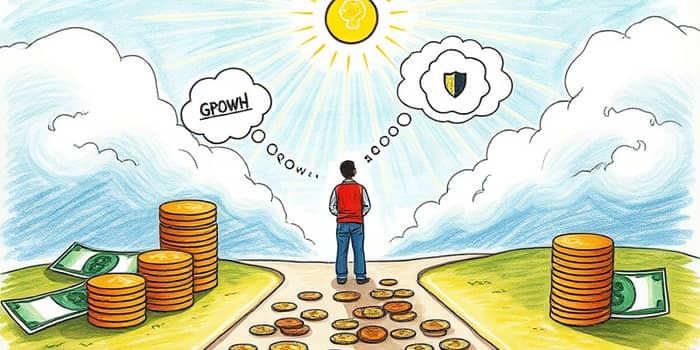Financial well-being goes far beyond numbers in a bank account. It intertwines with our emotions, beliefs, and daily behaviors, shaping everything from our stress levels to our long-term goals.
In this article, you’ll learn why mindset is as crucial as strategy, how deep-seated beliefs form early, and what you can do right now to transform your relationship with money.
Origins of Your Money Mindset
Your feelings about money often originate in childhood. By age five, children already show emotional responses to spending and saving, independent of parental modeling.
These early impressions are reinforced by family messages, societal norms, and personal experiences with windfalls or debt.
- Upbringing: scarcity or abundance messages
- Cultural influences and community norms
- Personal encounters with loss, poverty, or unexpected gains
Recognizing these roots is the first step toward rewiring your financial outlook and freeing yourself from unhelpful patterns.
Identifying Your Money Scripts
Dr. Brad Klontz and colleagues identified four core money scripts—automatic beliefs that drive financial behavior. Understanding your dominant script offers clarity on why you make certain choices.
Alongside these, the Spendthrift–Tightwad Scale measures emotional pain or pleasure tied to spending. Tightwads endure greater pain when spending money, while spendthrifts experience little friction and often overspend.
Key Psychological Drivers and Barriers
Saving isn’t just a rational choice. It’s influenced by deep-seated biases and emotional triggers.
Fear of loss—known as loss aversion—makes potential losses feel far more intense than equivalent gains, leading many to avoid investing or structured saving plans.
Stress and boredom frequently drive impulsive spending, hijacking the best intentions. Overconfidence can lure you into risky financial ventures without proper preparation.
On the other hand, strong self-control and deliberate mental budgeting—categorizing expenses in your mind—correlate directly with higher savings rates and better overall financial health.
Practical Strategies to Shift Your Mindset
Transforming your money mindset relies on combining insight with action. Start small and build momentum.
- Identify your money scripts by journaling emotions around income and expenses.
- Boost financial literacy: read trustworthy books, follow expert podcasts, or take a course.
- Implement mental budgeting: assign each dollar a role before it’s spent.
- Use automation: schedule automatic transfers to your savings to remove decision fatigue.
- Adopt a growth mindset: replace “I can’t afford it” with “How can I earn or save?”
- Seek professional support: financial therapists use the Klontz Inventory to reshape limiting beliefs.
Over time, these small habits compound into lasting financial resilience and confidence.
Common Mistakes and How to Overcome Them
Even with good intentions, some pitfalls resist simple discipline. Anticipate these challenges and prepare solutions.
- Relying solely on willpower: design systems that remove temptation and automate good behavior.
- Ignoring emotional roots: address beliefs like scarcity or undeserved wealth through reflection and therapy.
- Assuming early patterns are permanent: mindset is malleable with consistent practice and education.
By acknowledging these common errors, you can plan more effectively and stay on track.
Measuring Progress and Staying Motivated
Set clear, meaningful goals to connect saving with your core values—whether it’s family security, travel, or early retirement.
Track your milestones and celebrate small wins. Even a five-dollar increase in monthly savings is progress and deserves recognition.
Regular check-ins—weekly or monthly—help you adjust strategies, reaffirm purpose, and maintain momentum over the long haul.
Conclusion: Embrace a Growth Mindset
Mastering your money mindset is not an overnight transformation. It’s a journey of self-awareness, habit-building, and gradual belief change.
By understanding your emotional drivers, cultivating financial literacy, and leveraging behavioral tools, you can shift from fear-driven scarcity to confident wealth-building.
Start today: reflect on one money script, automate a small saving, or seek a trusted advisor. Each step forward brings you closer to true financial freedom and peace of mind.
References
- https://www.bensonfinancialgroup.com/blog-01/the-psychology-of-money-understanding-your-money-mindset
- https://giesbusiness.illinois.edu/news/2023/04/07/research-finds-thinking-about-money-affects-feelings-of-meaning-in-life
- https://michiganross.umich.edu/rtia-articles/new-research-shows-children-form-attitudes-about-money-young-age
- https://www.lumenafinancial.com/blog/understanding-money-mindset-how-your-psychology-shapes-your-financial-futu
- https://pmc.ncbi.nlm.nih.gov/articles/PMC10645357/
- https://www.imwealthpartners.com/blog/the-psychology-of-money-how-your-mindset-shapes-financial-success
- https://fidelityfinancett.com/the-psychology-of-saving-understanding-your-money-mindset/
- https://newprairiepress.org/jft/vol2/iss1/1/










